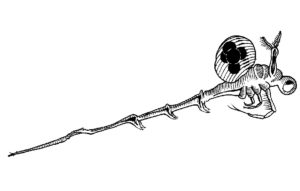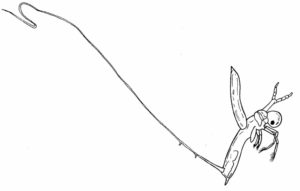Background
Spiny and fishhook waterfleas are small aquatic predators native to Eurasia. The first report of spiny and fishhook waterfleas in North America were both in Lake Ontario – spiny waterflea in 1982 and fishhook waterflea in 1998. Both species were introduced to the Great Lakes in ballast water from ocean-going ships. Both waterfleas are species of zooplankton – small animals that rely on water currents and wind to move long distances. Spiny and fishhook waterfleas prefer large, deep, clear lakes, but can also be found in shallower waters. Spiny waterfleas move to deeper, cooler waters during the day and swim towards the water surface at night to feed, while fishhook waterfleas stay near the surface. Both species are able to reproduce asexually, by cloning, and also sexually, and can multiply very quickly. When they reproduce sexually, the eggs can survive through the winter on lake bottoms and can be transported long distances on boats or equipment if they stay moist. The main diet of spiny and fishhook waterfleas is other zooplankton.
Range
The spiny waterflea has been found in all the Great Lakes and in more than 100 inland lakes in Ontario. The species has also been reported in Lake Winnipeg and the Winnipeg River in Manitoba. It is not known to be anywhere else in Canada, but has been found in inland lakes of American states that border the Great Lakes. The fishhook waterflea is established in lakes Ontario, Erie and Michigan, as well as some inland lakes in upstate New York.
Impacts of Spiny and Fishhook Waterfleas
Researchers believe that spiny waterfleas are the greatest threat to the biodiversity and structure of native zooplankton communities on the Canadian Shield since acid rain.
- Because their main diet is zooplankton, they reduce food supplies for small fish and the young of sport fish such as bass, walleye and yellow perch.
- A few animals can quickly multiply into a large population.
- They are easily spread between waterbodies on angling equipment and bait buckets and in live wells and bilge waters.
- Spiny waterflea introductions result in an average 30 to 40 per cent decline in native populations of zooplankton.
- Spiny and fishhook waterfleas can affect recreational angling and commercial fishing. Their tail spines catch on fishing equipment, making it difficult to reel in lines, and clogging commercial nets and trawl lines.
How to Identify Spiny and Fishhook Waterfleas
Spiny and fishhook waterfleas both have a single dark eye, four pair of legs and branched antennae that are used for swimming. You will need a microscope to identify key characteristics of each species. Check the chart below to know if you have a spiny or fishhook waterflea.
INVASIVE
Spiny Waterflea
(Bythotrephes longimanus)
Details
- Total length reaches one to 1.5 centimetres, with the tail spine making up about 60 per cent of the body length.
- Tail is straight or slightly angled with one to three barbs and a pointed end.
- May have orange, blue and green colouring. Red stripe runs half the length of the tail.
- Balloon-like egg pouch.
INVASIVE
Fishhook Waterflea
(Cercopagis pengoi)
Details
- Total length reaches one centimetre, with the tail spine making up about 80 per cent of the body length.
- Tail is strongly angled, with one to three widely spaced barbs and a loop or hook at the end.
- Transparent.
- Pointed, elongated egg pouch
What You Can Do
- Learn how to identify spiny and fishhook waterfleas and how to prevent accidentally spreading these invasive species.
- Inspect your boat, trailer and equipment after each use. Remove all plants, animals and mud before moving to a new waterbody.
- Drain water from your motor, live well, bilge and transom wells while on land.
- Clean all recreational equipment with a high pressure wash, hot water, OR let it dry in the sun for at least 5 days.
- If you’ve seen an invasive waterflea or other invasive species in the wild, please contact the toll-free Invading Species Hotline at 1-800-563-7711 or visit EDDMapS to report a sighting.
Gallery
OFAH/MNR Invading Species Awareness Program. (2021). Spiny and Fishhook Waterfleas. Retrieved from: www.invadingspecies.com.
This factsheet may be reproduced for non-commercial purposes.
Header photo by Andrea L. Jaeger Miehls, Michigan State University, bugwood.org



